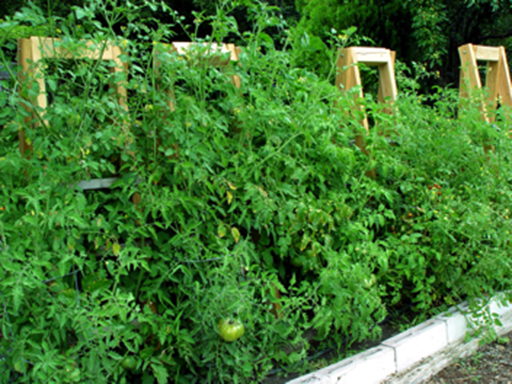Despite what the large home improvement stores would have you believe, you shouldn’t be planting tomato plants in April. Our weather (Spokane, WA, zone 5) is too iffy. If you are willing to watch the weather forecasts religiously then you could try mid-May. I usually put mine out around the first of June but then i am prepared to protect them if need be.
THE PLANNING STAGE
Be choosy. Choose varieties that will do best in your garden area. Every property has it’s own microclimates.
Sunshine and more sunshine. Site your tomato bed where they will get at least 8 hours of sun a day. If that is not an option, choose smaller fruited varieties such as early and cherry tomatoes. You are more likely to get something.
Rotate your tomato beds. This helps prevent diseases and keeps them from depleting the soil of vital nutrients (tomatoes are heavy feeders. That also includes potatoes and eggplants, which are in the same family)
Hardening off. Conventional wisdom says that before planting, you should harden them off for a week to 10 days, putting them out during the day and bringing them in at night. Since I grow them cool, I have never needed to harden mine off and have never had any problems. When in doubt…
Cold protection. Wall o’ waters, cover the cages with plastic or Remay, or even create a mini greenhouse by using PVC pipe and plastic sheeting to make a mini greenhouse. there are a variety of items you can use to try and save your plants.

VERTICAL OR HORIZONTAL?
Most tomatoes benefit from some kind of staking. Even determinate varieties. You can use wooden stakes, tomato cages, commercial or homemade or any kind of fencing that you train them up. Use soft ties that won’t bind such as old pantyhose or garden twine.
PLANTING YOUR TOMATOES
Plant 3 feet apart when staking or caging. If you let them sprawl, set them 18” apart. Research shows that the plants will produce a heavier yield if you let them sprawl, however, they are more prone to slugs, bugs, rot and diseases so you’ll actually harvest less.
Bury them as deep as you can or lay them on their sides in a trench. tomatoes grow roots all along their stems.
Instead of planting all your tomatoes in one bed, try spacing them throughout the garden. This will give them more room, more air flow and if they come down with a fungus or disease, it won’t spread as easily to the others. This strategy is useful if you are trying to save your own seed.
MAINTENANCE
Consistent watering is crucial, tomatoes need at least an inch of water a week. Keep area weeded and use mulch to help conserve moisture and prevent disease.
Fertilize plants, once when setting out and when they start to bloom/set fruit.
I don’t pinch suckers; the extra leaf coverage protects them from sunscald and provides more leaf/fruit ratio for photosynthesis and protection from sunburn.
FERTILIZERS
Sources: compost, manure (horse, cow, chicken, rabbit, lama etc,), fish fertilizer, bone meal (steamed), banana peels, fish, seaweed extract, egg shells, Be careful with manures, since they can burn your plants if not well composted. If they smell like manure, they aren’t ready. They should smell like dirt.
I use a combination of these things but for the most part, I don’t fertilize much after they are planted unless I see signs of a problem. Too much nitrogen gives you big beautiful leaves and plants but not much fruit. (Think body builders and steroids.)
I believe that if you feed the the soil, it will feed your plants, so most of my fertilizing is taken care of the soil prep work. We use composted manure (I have a horse) lawn clippings and dried leaves. In the spring , after it has composted in situ, we work it into the soil.
END OF SEASON
Here are several ways to motivate your tomatoes to ripen their fruit. Remember that the plants main purpose in life is to procreate and it panics when you do one or all of the following: reduce watering, shovel prune (dig around the outside of the plant about a foot away to sever some of the roots), and/or remove immature fruits and other blossoms. This stresses the plant.
If light frost threatens, cover with tarps, blankets, fabric sheets, plastic, or Remay, anything to keep the frost from touching the tomatoes themselves. Uncover during the day to keep from baking your plants. Most tomatoes will ripen if close to the size they need to be and if you pick them and put them on the kitchen counter or in the basement. IF the frost touches them, they will rot.
THE ABC’S OF FEEDING YOUR PLANTS. WHAT DOES IT ALL MEAN?
Four Most Important Nutrients:
(N) nitrogen, (P) phosphorus, (K) potassium, (CA) calcium. You will find the first three most commonly on a bag or bottle of fertilizer, organic or not. There are a lot more nutrients but these are the biggies.
 | Nitrogen: leaf and stem growth (not too much, big beautiful leaves not many fruits) Sources: fish emulsion, blood meal, compost, manure (well rotted) Symptoms: stunted growth and yellowing leaves |
 | Phosphorous: strong roots, formation of flowers and fruits, and disease resistance Sources: bone meal, chicken manure (well rotted) Symptoms: stunted growth, thin stems and a purplish cast in underside of leaves |
 | Potassium: plant growth, disease resistance, health and vigor Sources: granite meal, greens, wood ashes Symptoms: stunted growth, poor yields, yellow splotched foliage |
 | Calcium: leaf and cell wall growth. Plants need adequate moisture to utilize calcium Sources: bone meal, wood aches, ground limestone, crushed eggshells Symptoms: blossom end rot |
PROBLEMS IN THE GARDEN
BTW: It is hard to diagnose some problems since everything seems to have yellowing leaves as a symptom, either cultural, nutritionally or disease wise. Although tomatoes are easy to grow, you can still run into problems.
VFNTASt are letters that you like to see in the tomatoes description. They refer to the diseases that they are resistant to:
Verticulum – wilt
Fusarium – wilt
Nematodes
Tobacco – Mosaic
Alternaria
Stem Canker
Stemphylium
Gray Leaf Spot
Verticulum and Fusarium Wilt: leaves, curl up, turn yellow and drop off
Nematodes: tiny wormlike creatures that attack a plant’s root system, stunting growth and lowering disease resistance
Tobacco Mosaic: curling, stunted leaves, don’t smoke around plants or touch them without washing hands
Early Blight: very common, lower leaves affect first, brown spot surrounded by yellowing, mulch to prevent splashing of spores from ground
Too Hot: blossoms fall off, shrivel up or die (extended temps over 90) lack of pollination
Blossom End Rot: black, scabby looking bottom, caused by inconsistent watering and a lack of calcium
Another common question is about the ugly brown spot on the end of tomatoes, particularly paste tomatoes. That is Blossom End Rot (see above for the “why”) Keep your watering consistent. When it happens, use crushed eggshells, it worked for me within a week of application. Didn’t cure the already damaged ones but it prevented it from the new ones. Another options is to put a handful of crushed eggshells in the planting hole.
Cat Facing: gnarled, abnormal formation of fruit, caused by cold temps, still edible, just ugly, some heirlooms are naturally that way
Damping off: a fungal disease that causes the stems to rot at the soil line. Use sterile soil and pots, a dusting of sphagnum moss or vermiculite on the surface, good light and circulation when starting seeds
It is important that you don’t put the infected plants in the compost pile. Bag them and toss into garbage.
Fungus problems: This year I am going to try something different. Once they have started to grow, prune the first couple of lower branches to keep them from touching the ground. This should help keep little beasties from coming on board through the leaves and help keep water droplets from bouncing up so much and infecting the plants with some nasty fungus. I will let you know if this works.
Pests
Flea Beetles, aphids and hornworms: Hand pick or use BT. You can also try to spray the plants free of aphids with a hose
Slugs: Boy did I have them last year, little baby ones. I was keeping an eye on a large, luscious Virginia Sweet and when I picked it, the bottom half of it was be gone. I was not a happy camper. This year, I am going to try using copper strips or wire around the base of my plant, think dracula and garlic. Other things to try are diatomacious earth or eggshells and beer.
Large Beasties: Deer, Rabbits, Dogs, Chipmunks: There are a mllion solutions offered on the internet. Some work, some dont. You just have to keep trying. Fencing is a good option.

